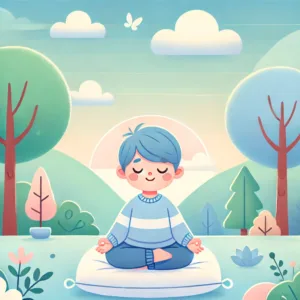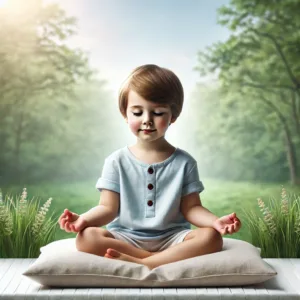Explore the benefits of guided meditation for kids with simple, fun, and calming practices that promote mindfulness, focus, and emotional well-being.
Table of Contents
guided meditation for kids
1.Guided Meditation for Kids Building Focus and Calm in a Playful Way.
2.In today’s fast-paced world, kids are often swept into the hustle and bustle just like adults.
3.Whether it’s keeping up with schoolwork, navigating social relationships, or simply adjusting to the many changes that come with growing up, children experience stress too.
4.But unlike adults, they might not have the tools to manage these feelings.
5.That’s where guided meditation comes in—a fun, calming way to help kids slow down, breathe, and relax.
6.Guided Meditation for Kids like going on a peaceful adventure, all from the comfort of their own minds.
What is Guided Meditation for Kids?

1.Think of Guided Meditation for Kids as storytelling with a purpose.
2.Instead of following a book or TV show, guided meditation allows kids to use their imagination while they relax and tune into their inner world.
3.It helps them take a break from the outside chaos and find peace within themselves.
4.When kids practice guided meditation, they’re invited to picture a soothing scene—a beach, a forest, or even their own cozy bedroom—and focus on how it makes them feel.
5.These gentle suggestions are a great way to lead kids through the process of mindfulness being fully present in the moment without being swept away by thoughts and worries.
6.Guided Meditation for Kids doesn’t ask kids to sit in silence for hours. Instead, it provides structure and imagination, helping them gradually develop the habit of stillness and relaxation.
7.Through practice Guided Meditation for Kids , kids not only feel calmer, but they also gain skills that help them better manage their emotions, concentrate on tasks, and even improve their sleep.
Why is Guided Meditation Important for Kids?
1.As adults, we often forget that kids feel stress too. Maybe it’s from school, where they’re learning new concepts every day. Or perhaps it’s from friendships, which can sometimes be tricky to navigate.
2.Family life, extracurricular activities, or even unexpected changes in routine—like moving to a new house—can also pile on the pressure.
3.Kids may not always have the words to express their stress. Instead, you might see them act out in frustration, withdraw in sadness, or become overwhelmed by things that seem small.
4.This is because, developmentally, children are still learning how to regulate their emotions.
5.Guided Meditation for Kids can be a gentle, supportive way to help them figure this out.
6.When we teach kids to meditate, we’re giving them a life-long tool. They learn to recognize their emotions without being controlled by them.
7.Guided Meditation for Kids helps them pause and observe their thoughts, giving them a little space to respond in a more thoughtful way, rather than just reacting impulsively.
8.In fact, studies have shown that mindfulness practices like meditation can:
9.Kids who meditate tend to feel more relaxed and calm, which can help them manage everyday worries.
10.Guided Meditation for Kids Improve concentration enhances attention spans, helping kids focus better in school and during activities.
11.By reflecting on their emotions, kids become more aware of how they feel and learn to express themselves in healthier ways.
12.A calming meditation before bed can create a peaceful transition into sleep, especially for kids who have trouble winding down at night.
When is a Good Time to Meditate with Your Child?

Guided Meditation for Kids doesn’t need to be a formal or rigid practice, especially for kids.
The best time to introduce guided meditation to children is during moments when they naturally need a bit of calm or relaxation.
Here are a few ideas:
1.After a busy day of learning, kids can benefit from a few minutes of quiet to reset before tackling homework or other after-school activities.
2.Before Bed Guided Meditation for Kids can help ease the transition from a busy day to a restful sleep. A bedtime meditation ritual can become something your child looks forward to, creating a peaceful end to the day.
3.During a Difficult Moment If your child is feeling overwhelmed, frustrated, or sad, a short Guided Meditation for Kids can help them step back from their emotions and find a sense of calm.
4.Start the weekend on a calm note with a morning meditation that sets a positive tone for the day ahead.
A Simple and Fun Guided Meditation for Kids
Let’s walk through a Guided Meditation for Kids that you can do with your child anytime.
This one is short, fun, and designed to be easy for beginners. You don’t need any special tools—just a quiet space and a little imagination.
Step 1:
Get Cozy
1.Invite your child to find a comfortable spot.
2.It could be lying down on their bed, sitting on the couch, or even curling up with their favorite blanket.
3.The goal is to make them feel as comfortable as possible, so they can relax and focus without distractions.
4.You can start with some gentle instructions like “Close your eyes and let your body relax.
5.Take a deep breath in through your nose and then slowly breathe out through your mouth.
6.Feel your body getting heavier and heavier, sinking into the bed or floor.”
Step 2:
Breathe Deeply
1.Once they’re comfortable, guide them through a simple breathing exercise.
2.Explain that breathing deeply helps calm the mind and body.
3.Imagine you’re blowing up a balloon with your breath.
4.Breathe in through your nose and fill up your belly with air, then slowly blow out the air as if you’re letting the balloon float away.”
5.Encourage them to take three or four deep breaths like this, focusing on how their body feels with each inhale and exhale.
6.The slower they breathe, the calmer they will feel.
Step 3:
Picture a Happy Place
1.Now it’s time to spark their imagination.
2.Ask your child to think of a place that makes them feel safe, happy, and peaceful.
3.It could be real or imaginary—there are no limits here.
4.Now close your eyes and imagine you’re in your happy place.
5.Maybe it’s a beach where the sand is warm and soft, or a forest with tall trees and gentle breezes.
6.You might even imagine floating on a fluffy cloud high up in the sky. What do you see? What can you hear? Is there a soft breeze, or do you hear birds singing?”
7.The goal is to help your child immerse themselves in this place, using all their senses to paint a vivid picture in their mind.
8.This imaginative exercise helps kids focus on positive emotions and disconnect from any stress they might be feeling.
Step 4:
Feel Your Body Relax
1.Now, guide your child to focus on how their body feels.
2.Start from the top of their head and slowly work your way down to their toes.
3.Let’s start with your head. How does it feel? Can you relax your forehead and eyes?
4.Now, let’s move down to your shoulders. Are they tight or tense? Let’s relax them and let them feel heavy, like they’re sinking into the bed or floor.”
5.Continue this body scan, helping your child relax each part of their body, one by one.
6.This technique helps kids release any built-up tension, bringing awareness to areas of their body they may not normally notice.
Step 5:
End with Gratitude
1.Once your child’s body is relaxed, invite them to think about something they’re grateful for.
2.This simple gratitude practice can help shift their focus to the positive aspects of their day.
3.Before we finish, let’s think about something you’re thankful for today.
4.Maybe it’s the fun game you played at recess, or the hug you got from a friend.
5.Hold that happy thought in your heart and feel the warmth it brings.”
6.End the meditation by asking your child to take a few more deep breaths, then gently open their eyes when they’re ready.
How to Make Fun and Engaging Guided Meditation for Kids
Guided meditation should feel like a peaceful adventure for kids, not a chore.
Here are some creative ways to make it more engaging and fun:
Use Storytelling:
Frame the meditation as a story, where your child is the main character going on a magical journey.
The more vivid and imaginative the story, the more engaged they’ll be.
Create a Meditation Corner:
Set up a cozy, special spot in your home for meditation.
Fill it with soft pillows, blankets, and maybe a few of their favorite stuffed animals.
Having a dedicated space can make the experience feel more inviting.
Incorporate Music or Nature Sounds:
Soft background music or nature sounds like waves or birds chirping can make the meditation experience more immersive for kids.
Let Them Lead:
As your child becomes more familiar with meditation, encourage them to lead a session. Let them guide you through their own imagined happy place or breathing exercise.
Common Challenges (and How to Overcome Them)
While Guided Meditation for Kids can be a great tool, it’s natural for some kids to struggle at first.
Fidgeting and Restlessness:
Some kids may find it hard to sit still for long periods, and that’s okay.
Start with short meditations—just a few minutes—and gradually increase the time as they become more comfortable.
Encourage them to focus on their breathing if they start to fidget.
Wandering Thoughts:
It’s normal for a child’s mind to wander during meditation.
Gently guide them back to the practice with phrases like, “It’s okay if your mind wandered.
Let’s bring it back to your happy place.
Lack of Interest:
If your child isn’t engaged, try a different approach.
Use more storytelling, introduce fun breathing exercises, or incorporate something that aligns with their interests.
For example, if your child loves animals, you could ask them to imagine a peaceful meadow filled with their favorite creatures. Each meditation session can be a new adventure.
It’s important not to force it; instead, find ways to naturally integrate the practice into moments when they might already be feeling calm or open to new ideas.
Difficulty Visualizing:
Some children might struggle with visualizing a calm place, and that’s okay too.
Not every child will immediately connect with the imaginative aspect of guided meditation.
You can try describing the place in more detail for them or ask them to focus on a different sense, like the feeling of warmth on their skin or the sound of waves.
Over time, their ability to imagine and visualize will improve.
Restless Energy:
Kids often have a lot of energy, making it difficult for them to sit still during meditation.
You can address this by incorporating a few minutes of movement or light stretching before starting the meditation.
This can help them release some of their excess energy and prepare for a more relaxed experience.
Guided Meditation as a Tool for Lifelong Skills

1.Guided Meditation for Kids isn’t just about feeling calm in the moment—it’s about giving kids tools they can carry with them throughout life.
2.These are skills that will serve them well into adulthood, helping them navigate challenges, stress, and emotional ups and downs with greater resilience and awareness.
3.One of the most valuable aspects of guided meditation is that it helps children develop emotional intelligence.
4.When kids regularly practice mindfulness, they become more attuned to their emotions, learning how to recognize and manage them in healthy ways.
5.For example, a child who has practiced meditation might recognize that they’re feeling frustrated and, instead of reacting with anger, they take a moment to breathe and calm down.
6.This awareness and control over emotions are essential for building stronger relationships, both with peers and family members.
7.It also contributes to a more positive self-image.
8.Kids who meditate regularly often develop a stronger sense of self-worth, as they learn to trust in their ability to manage their own thoughts and feelings.
9.Guided Meditation for Kids also supports cognitive development.
10.Focusing on breathing or visualizing calm scenes can strengthen the brain’s ability to concentrate and pay attention.
11.This can translate to better performance in school and more engagement with hobbies and creative activities.
12.Kids who meditate are often better able to block out distractions and stay focused on tasks at hand.
13.One of the best things about guided meditation is its flexibility.
You can incorporate it into everyday life in so many creative ways.
Guided Meditation for Kids doesn’t always have to be a formal sit-down practice.
Here are a few ideas on how to weave mindfulness and meditation into your child’s day without it feeling like a structured activity:
Before your child leaves for school, guide them through a quick breathing exercise or visualization to set a positive tone for the day.
Mindful Walks:
If your child enjoys being outside, take them on a mindful walk. During the walk, ask them to pay attention to the sights, sounds, and smells around them. Ask, “What do you hear? What do you see? Can you feel the wind or the warmth of the sun?”
Mindful Mealtime:
Mealtime can be another opportunity for mindfulness.
Ask your child to notice the textures, tastes, and smells of their food.
Encourage them to eat slowly and focus on how the food feels in their mouth.
Not only does this promote mindfulness, but it also helps kids develop a greater appreciation for their meals and encourages healthier eating habits.
Breathing Breaks:
Throughout the day, whenever your child seems overwhelmed or stressed, you can encourage them to take a “breathing break.” This is a quick and easy way to reset their emotions. Ask them to pause, take a deep breath, and then release it slowly.
How to Measure Progress
As with any new skill, progress in meditation takes time, and it’s important not to rush or force results.
With kids, the goal isn’t perfection—it’s progress. Here are a few ways to measure how meditation is benefiting your child:
1.Over time, you might notice that your child is less prone to mood swings and tantrums. They may begin handling difficult emotions like frustration, anger, or sadness with more patience and calm.
2.If your child starts focusing better during school or homework, meditation could be playing a role. Pay attention to how well they concentrate on tasks after meditation.
3.A more restful sleep pattern is a common benefit of meditation.
4.If bedtime becomes easier and your child starts waking up feeling more refreshed, meditation might be helping them wind down at night.
5.One of the long-term benefits of mindfulness is greater self-awareness.
6.As your child practices meditation, they’ll become more in tune with their thoughts, feelings, and behaviors.
7.They might start to express themselves more clearly or recognize when they need a moment of quiet.
Conclusion:
Starting the Journey Today
Guided Meditation for Kids offers a gentle, engaging way to help children build important emotional and cognitive skills that will benefit them for the rest of their lives.
It doesn’t have to be complicated or time-consuming; even a few minutes a day can make a difference.
By incorporating Guided Meditation for Kids into your child’s routine—whether through playful storytelling, mindful walks, or simple breathing exercises—you’re giving them the tools they need to navigate life with greater calm, focus, and self-awareness.
Why not start today?
Take a moment with your child to sit together, breathe deeply, and imagine a peaceful place.
You might be surprised by how much they enjoy it—and how much it helps them grow into calmer, more mindful individuals.



